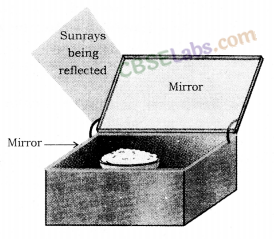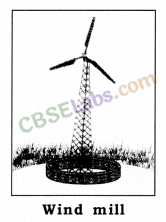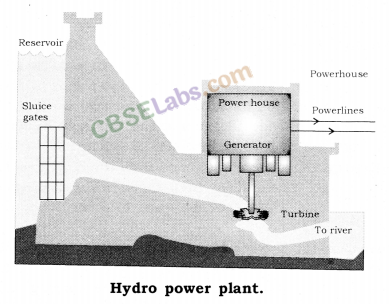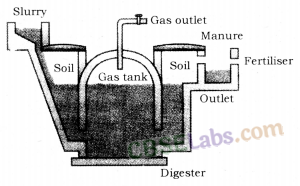CBSE Class 10 Science Notes Chapter 14 Sources of Energy Pdf free download is part of Class 10 Science Notes for Quick Revision. Here we have given NCERT Class 10 Science Notes Chapter 14 Sources of Energy. According to new CBSE Exam Pattern, MCQ Questions for Class 10 Science pdf Carries 20 Marks.
CBSE Class 10 Science Notes Chapter 14 Sources of Energy
Acids: Indicators, General characteristics, Properties of acids, Chemical nature of acids.
Sources of Energy: A source of energy is that which is capable of providing enough useful energy at a steady rate over a long period of time.
A Good source of energy should be :
- Safe and convenient to use, For example; energy nuclear can be used only by highly trained engineers with the help of nuclear power plants. It cannot be used for our household purpose.
- Easy to transport, For example; coal, petrol, diesel, LPG etc. have to be transported from the places of their production to the consumers.
- Easy to store, For example; huge storage tanks are required to store petrol, diesel, LPG etc.
Characteristics of a good fuel
- High calorific value.
- Less smoke.
- Less residue after burning.
- Easy availability.
- Inexpensive.
- Easy to store and transport.
Classification of Sources of energy
The sources of energy can be classified as follows :
- Renewable sources of energy.
- Non-Renewable sources of energy.
1. Renewable sources of energy:
Renewable sources of energy are those which are inexhaustible, i.e., which can be replaced as we use them and can be used to produce energy again and again.
These are available in an unlimited amount in nature and develop within a relatively short period of time.
Example of Renewable Sources of Energy :
- Solar energy.
- Wind energy.
- Water energy (hydro-energy).
- Geothermal energy.
- Ocean energy.
- Biomass energy (firewood, animal dung and biodegradable waste from cities and crop residues constitute biomass).
Advantages of Renewable Sources of Energy
- These sources will last as long as the Earth receives light from the sun.
- These sources are freely available in nature.
- These sources do not cause any pollution.
2. Non-Renewable Source of Energy:
Non-renewable sources of energy are those which are exhaustible and cannot be replaced once they have been used. These sources have been accumulated in nature over a very long period of millions of years.
Examples of Non-renewable Sources of Energy :
- Coal.
- Oil.
-
Natural gas.
All these fuels are called fossil fuels.
Disadvantages of Non-renewable Sources of Energy
- Due to their extensive use, these sources are fast depleting.
- It is difficult to discover and exploit new deposits of these sources.
- These sources are a major cause of environmental pollution.
Fossil Fuels:
Fossil fuels are the remains of prehistoric plants and animals which got buried deep inside the early millions of years ago due to some natural processes.
These fossil fuels are non-renewable sources of energy and cause environmental problems due to pollution.
Formation of Fossil Fuels: During its formation, an entire organism or its parts often get buried in sand or mud. These, then decay and disintegrate leaving no signs of their existence. Infact, the harder parts of organisms after their death settle down and are covered by sediments and subjected to extreme pressure and temperature or the Earth converts them into fossil fuels, the process being referred to as fossilization.
Disadvantage of Fossil Fuels
- The fossils are non-renewable sources of energy and once used cannot be renewed.
- Burning of fossil fuels causes air pollution.
- The fossil fuels reserves in the Earth are limited and may get exhausted soon.
Thermal Power Plants:
It generates electricity from heat produced by combustion of coal and petroleum. For example; fossil fuels.
Use coal, petroleum and natural gas produce thermal electricity.
Electricity transmission is very efficient.
The steam produced by burning fossil fuels nans the turbine to produce electricity.
Source of energy are also classified as
- Conventional sources of energy and
- Non- conventional sources of energy.
(i) Conventional Sources of Energy are those which are used extensively and meet a marked portion of our energy requirement and these are :
(a) Fossil fuels (coal, oil and natural gas) and
(b) Hydro energy (energy of water flowing in rivers).
Biomass energy and wind energy also fall in this category as these are being used since ancient times.
(ii) Non-conventional Sources of Energy are those which are not used as extensively as the conventional ones and meet our energy requirement only on a limited scale. Solar energy, ocean energy, (tidal energy, wave energy, ocean thermal energy, OTE), Geothermal energy and nuclear energy belong to this category. These sources of energy which have been tapped with the aid of advances in technology to meet our growing energy needs are also called alternative sources of energy.
Renewable Sources of Energies
1. Solar Energy:
The energy produced by the sun in the form of heat and light energy is called as solar energy.
Solar radiations can be converted electricity through solar cells (Photovoltaic cells).
Photovoltaic cells convert solar radiations directly into electricity through silicon solar cells.
Solar cells arrange on a large flat sheets form a Mirror solar panel.
Solar cookers are painted black from outside and a large glass plate to trap solar radiations by green house effect.

Advantages of Solar Cookers
- Eco-friendly.
- Renewable.
- Used in rural areas.
- Retains all the nutrients in food due to slow cooking.
Disadvantage of Solar Cookers :
- Silicon cells are expensive.
- Solar radiations are not uniform over the Earth’s surface.
- Cannot be used at night or on cloudy days.
- Cannot be used to make chapattis for frying as these require a temperature of 140°C or more. (Maximum temperature of 100°C only can be achieved in a solar cooker) Other Solar Devices are Solar water heater and Solar furnace.
2. Wind Energy:
When large masses of air move from one place to another then it is referred to as wind. During this process, kinetic energy gets associated with it which is referred to as wind energy.
It can be converted into mechanical and electrical energy.
Kinetic energy of wind is used in running of windmills, which are used to lift water, grind grains etc.

Uses of Wind Energy
The important uses of wind energy are :
- It is used to drive windmills, water lifting pumps, and flour mills, etc.
- It is used to propel sale boats.
- It is used to fly engine fewer airplanes or gilders in the air.
- It is used to generate electrically used for various purposes like lightning, heating, etc.
Advantages:
- Eco-friendly
- Renewable.
Disadvantages :
- Wind speed does not uniform always.
- Needs a large area to erect series of windmills.
- Big amount of investment is needed.
- The output is less as compared to investment.
3. Hydro Power Plant (hydro energy):
When the water flowing in a river is stored in a high rise dam and allowed to fall from the top of the dam. The water rushes down with a great force, which can be utilized to drive large water Lurbine. These turbines are connected with electric generators which generate electric current. The electricity generated in this process is termed as hydroelectricity or hydel power. In fact the process involves transference of potential energy of the water into kinetic energy’ and then into electric energy.
It is the most conventional renewable energy source obtained from water falling from a great height.
It is clean and nonpolluting source of energy.
Dams are constructed to collect water flowing in high altitude river. The stored water has a lot of potential energy.
When water is allowed to fall from a height, potential energy changes to kinetic energy which rotates the turbines to produce electricity.

Advantages of Hydro Power Plant :
- It is readily and abundantly available everywhere free of cost.
- It is eco-friendly and does not produce any kind of environmental pollution.
- It is a renewable source as water itself is a renewable and inexhaustible resource.
- It is a cheap source of energy, as it does not involve any costly investment.
Disadvantages of Hydro Power Plant
- Highly expensive to construct.
- Dams cannot be constructed on all river sites.
- Large areas of human habitation and agriculture fields get submerged.
- People face social and environmental problems.
4. Geothermal Energy:
Geothermal energy is the heat of the Earth and is the naturally occurring thermal energy found within rock formations and the fluids held within those formations.
Energy harnessed from the heat of the Sun is called Geo Thermal Energy.
Magma is formed when this heat melts the rocks. The rocks and hot gases are called magma.
The magma gets collected at some depths below the Earth’s surface. These places are called ‘Hot spots’.
When underground water comes in contact these hot spots, it changes into steam, which can be used to generate electricity.
Advantages of Geo Thermal Energy
- Renewable
- Inexpensive
Disadvantages of Geo Thermal Energy
- Only a few sites are available for harnessing energy.
- Expensive
5. Ocean Energy:
The oceans acquire almost 71% of the surface of the Earth. The enormous amount of water present in them did not act as a big collector of solar heat energy, but also store large amount of it due to its high specific heat. Thus, ocean water can be used as a renewable resource of energy.
The main forms of ocean energy are described as under :
(i) Ocean Thermal Energy:
The energy available due to the temperature difference between the deeper levels and surface of an ocean is called as Ocean Thermal Energy,
(ii) Ocean Tidal Energy: The rise of ocean water due to the attraction of the moon is referred to as high tide and its fall as low tide. The enormous movement of water due to high and low tide provide a large amount of energy known as Ocean Tidal Energy. This tidal energy can be utilized by constructing a tidal barrage or dam.
(iii) Sea Wave Energy: The energy obtained from the high-speed sea waves is referred to as sea wave energy. Infact, these high-speed sea waves have a lot of kinetic energy associated with them, which can be used to drive dynamos which convert kinetic energy into electrical energy.
(iv) Energy from Nuclear Deuterium of Oceans: The oceans water contains an unlimited amount of heavy hydrogen isotope called as deuterium which is isotope hydrogen having one neutron in its nucleus. Scientists are working hard to produce energy by carrying the controlled nuclear fission of deuterium isotope. The process is still in its experimental stage.
(v) Energy From Salinity Gradient in Seas: The difference in the concentration of salts in the water of the two or more seas is called a salinity gradient. This salinity gradient is now a day used to obtain energy with the involvement of suitable techniques,
(vi) Energy From Sea Vegetation or Biomass:
Sea vegetation or biomass is another direct source of energy because the enormous amount of seaweeds present in the sea water provides an endless supply of methane fuel.
Disadvantages: Uniform tidal action is not seen.
6. Bio-Mass:
Biomass is defined as living matter or its residue and is a renewable sources of energy.
The biomass includes
- all the new plant growth
- agriculture and forest residues (like Bio-gases, dark, sea dust, wood savings, roots, animals dropping, etc..),
- Carbonaceous wastes (like sewage, garbage, night-soil, etc.)
- Biodegradable organic effluent from industries.
It is the source of the conventionally used fuels that are used in our country. For example; Cow dung cakes, fire-wood, coal, charcoal etc.

Bio-gas:
It is a mixture of gases produced during decomposition of bio mass in the absence of oxygen. (Anaerobic Respiration). Methane is the major component of bio-gas.
Bio-gas plants:
Animal dung, sewage, crop residues, vegetable wastes, poultry dropping, etc. are used to produce Bio-gas in Bio-gas plants.
Advantage of Bio-gas
- A Bio-gas plant, is quite simple, can easily be built in rural areas. A small plant using dung from 3 to 4 heads of cattle is capable of supplying Bio-gas for 6 hours daily for cooking purposes.
- Bio-gas is a clean fuel that burns without smoke and leaves no ash.
- The main constituent of Bio-gas, i.e., ethane has a higher calorific value (55 kj/g) that of petrol (50kj/g).
- The spent slurry, being rich in nitrogen and phosphorus is good manure.
- By using Bio-gas, firewood is saved and deforestation is reduced.
Composition of Bio-gas: Bio-gas is mainly composed of methane (up to 75%), C02 (25%) and traces of other gases such as nitrogen and hydrogen. Whereas methane is a high-value calorific fuel, carbon dioxide is an inert gas.
7. Nuclear Energy:
A reaction in which, the nucleus of an atom undergoes a change to form a new atom and releases an enormous amount of energy is called as nuclear energy. There are two distinct ways of obtaining nuclear energy, (a) Nuclear fission and (b) Nuclear fusion.
Energy released when some changes take place in the nucleus of the atom of a substance is called Nuclear energy.
It is used for heat generation, fuel for marine vessels.
Advantages of Nuclear Energy
- The alternative source of energy due to depletion of fossil fuels.
- From a small amount of fuel, a large amount of energy is released.
Disadvantages of Nuclear Energy :
- Risk of nuclear waste leakage.
- High cost of setting up of nuclear plant.
- Pollution of environment.
Environmental consequences of the increasing demand for energy :
- The combustion for fossil fuels produces acid rain and damages plants (crops), soil and aquatic life.
- The burning of fossil fuels is increasing the amount of greenhouse gas, carbon dioxide in the atmosphere.
- The construction of hydropower plants is a disturbing ecological balance.
- Nuclear power plants are increasing radioactivity in the environment.
Difference between Nuclear Fission and Fusion
| Nuclear Fission | Nuclear Fusion |
| 1. It involves breaking of a heavy nucleus into lighter nuclei. | 1. It involves the binding of two nuclei. |
| 2. It is carried out by the bombardment of neutrons over a heavy nucleus. | 2. It is carried out by heating an extreme temperature. |
| 3. It is a chain reaction. | 3. It is not a chain reaction. |
| 4. It is a controlled process. | 4. It is an uncontrolled process. |
| 5. It produces an enormous amount of energy. | 5. It produces more energy than nuclear fission. |
| 6. Fission products are hazardous. | 6. It does not cause pollution. |
Need for Energy: The ability of a body to do work is called energy. No activity will occur without energy. So energy is required in all walks of life.
Characteristics of a good source of energy.
- It should be able to do a large amount of work for each unit of mass or volume.
- It should be easily accessible.
- It should be easily transported.
- It should be economical.
Conventional Sources of Energy.
The sources of energy which have been in use since a long time are called conventional sources of energy. For example, Coal, petroleum, natural gas, hydel energy, wind energy and nuclear energy are considered to be the conventional sources of energy. Firewood is also a conventional source of energy but its usage is now limited to kitchens in rural India.
Fossil Fuels.
Coal:
Coal was formed millions of years ago. The plants got buried under swamps and due to high pressure and high temperature inside the earth; they were converted into coal. Coal is the highest used energy source in India. During the days of the steam engine, coal was used in steam engines. Moreover, coal was also used as kitchen fuel; before LPG became popular. Nowadays, coal is mainly being used in industries.
Petroleum:
Petroleum was also formed millions of years ago. The animals got buried under the ocean surface and were converted into petroleum; in due course of time.
Petroleum is the third major source of energy being used today. Petroleum products are used as automobile fuel and also in the industries. Natural gas mainly comes from the oil wells and is also a major source of energy.
Non-renewable Sources of Energy.
It takes millions of years for the formation of fossil fuels. Since they cannot be replenished in the foreseeable future, they are known as non-renewable sources of energy.
Renewable Sources of Energy.
Those sources of energy which can be replenished quickly are called renewable sources of energy. Hydel energy, wind energy and solar energy are examples of renewable sources of energy.
Hydel Energy: Hydel energy is produced by utilizing the kinetic energy of flowing water. Huge dams are built over a source of water. Water is collected behind the dam and released. When the water falls on the turbine; the turbine moves; because of kinetic energy of water. Thus, electricity is generated by the turbine. Electricity; thus generated is called hydel energy or hydroelectricity.
Limitations of Hydroelectric Plants.
- Dams can be constructed only in a limited number of places, preferably hilly areas.
- Large areas of agricultural land and human habitation get destroyed by the cons¬truction of dams.
- Large eco-systems get submerged under water. The vegetation which is submerged underwater rots under anaerobic conditions and gives rise to large amounts of methane which is a greenhouse gas.
- Rehabilitation of displaced people is another major problem.
Thermal Power Plant: In a thermal power plant, coal or petroleum is used for converting water into steam. The steam is used to rim the turbine; to generate electricity.
Biomass:
The material obtained from the bodies of plants and animals is called biomass.
Examples: cattle dung, sewage, crop residue, wood, etc.
Biogas: Biogas is a mixture of methane, carbon dioxide, hydrogen and hydrogen sulphide. It contains 65% of methane gas. Biogas is produced by the anaerobic degradation of bio¬mass in the presence of water but in the absence of air.
Wind Energy: Wind energy has been in use since ages. Windmills have been in use; especially in Holland; since the medieval period. Nowadays, windmills are being used to generate electricity. The kinetic energy of wind is utilized to run the turbines; which generate electricity. At present, Germany is the leading country in terms of wind energy production and India comes at number five. In India, Tamil Nadu is the largest wind energy producing state. The largest wind farm in India is near Kanyakumari; in Tamil Nadu; which generates 380 MW of electricity.
Limitations of Wind Energy: Wind farms can only be established at those places where the wind speed is high enough and is more than 15 km/hr for most parts of the year. Wind farms need to be established on large tracts of land. The fan of the windmill has many moving parts; so the cost of maintenance and repair is quite high. The initial cost of establishing a wind farm is very high.
Non-conventional Sources of Energy: Energy sources which are relatively new are called non-conventional sources of energy, e.g., nuclear power and solar energy.
Solar Energy: The sun is the main source of energy for all living beings on this earth. Even the energy in the fossil fuels has come from the sun. The sun has an endless reservoir of energy which would be available as long as the solar system is in existence. Technologies for harnessing the solar energy have been developed in recent times.
Solar Cooker: Solar cooker is very simple in design and mode of function. It is usually made from mirrors. Plain mirrors are placed inside a rectangular box. The light reflected from the plain mirrors concentrates the solar energy inside the solar cooker which generates enough heat to cook food.
Solar Furnace: Solar furnace is made like a concave mirror. Large solar furnace has many smaller mirrors to compose a very large convex mirror. The thing to be heated is placed near the focus of the mirror.
Solar Cells: Solar cells are made from silicon. The solar panel converts solar energy into electrical energy which is stored in a battery; for later use.
Limitations of Solar Energy: The technologies for harnessing solar energy are at a nascent stage. At present, the cost-benefit ratio for using solar energy is not conducive. Using solar energy is exorbitantly costly.
Tidal Energy: Due to the gravitational pull of the moon, tides happen near seashores. Water rushes up near the seashore during high tide and goes down during low tide. Dams are built near seashores to collect the water which comes during a high tide. When the water runs back to the ocean, the flow of water can be utilized to generate electricity.
Wave Energy: Waves can also be a good source of energy. Many devices are being designed and tested to produce wave energy. For example; a hollow tower is built near the seashore. When water gushes in the tube because of wave, it forces the air upwards. The kinetic energy of air in the tube is used to run a turbine. When the wave goes down; air from up goes down the tube which is also used in running the turbine.
Ocean Thermal Energy: The water at sea surface is hot during the daytime, while the water at a lower level is cold. The temperature differential in water levels can be utilized to generate energy. If the temperature differential is more than 20°C, then ocean thermal energy can be utilized from that place. For this, a volatile liquid; like ammonia; is boiled using the heat from the hot water at the surface. The steam of the volatile liquid is utilized to run the turbine to generate electricity. Colder water from the surface below is utilized to condense ammonia vapour which is then channelized to the surface to repeat the cycle.
Geothermal Energy: Heat energy from molten rocks present inside the earth created under certain favourable conditions by natural processes is called geothermal energy. It is the only type of energy which does not use solar energy.
Nuclear Energy: Nuclear fission is the process during which a bigger nucleus breaks to produce two smaller nuclei. The process generates a huge amount of energy. This phenomenon is utilized in nuclear power plants. Nuclear power is safest for the environment but the risk of damage due to accidental leaks of radiation is pretty high. Further, the storage of nuclear waste is a big problem because of the potential risk of radiation involved.
Advantages of nuclear energy.
- A very large amount of energy can be produced by a nuclear process on using very small amount of nuclear fuel in a nuclear reactor.
- The energy so produced can be easily transformed into electrical energy.
- It does not produce harmful gases.
NCERT Notes for Class 10 Science
- Chapter 1 Chemical Reactions and Equations Class 10 Notes
- Chapter 2 Acids Bases and Salts Class 10 Notes
- Chapter 3 Metals and Non-metals Class 10 Notes
- Chapter 4 Carbon and its Compounds Class 10 Notes
- Chapter 5 Periodic Classification of Elements Class 10 Notes
- Chapter 6 Life Processes Class 10 Notes
- Chapter 7 Control and Coordination Class 10 Notes
- Chapter 8 How do Organisms Reproduce Class 10 Notes
- Chapter 9 Heredity and Evolution Class 10 Notes
- Chapter 10 Light Reflection and Refraction Class 10 Notes
- Chapter 11 Human Eye and Colourful World Class 10 Notes
- Chapter 12 Electricity Class 10 Notes
- Chapter 13 Magnetic Effects of Electric Current Class 10 Notes
- Chapter 14 Sources of Energy Class 10 Notes
- Chapter 15 Our Environment Class 10 Notes
- Chapter 16 Management of Natural Resources Class 10 Notes